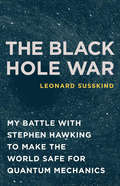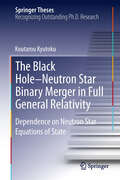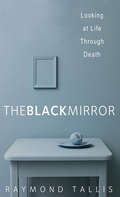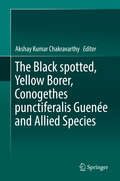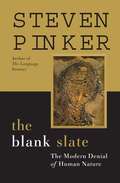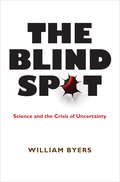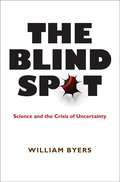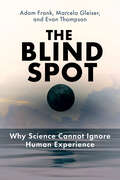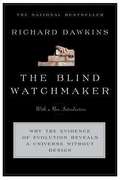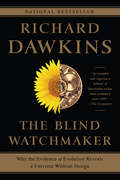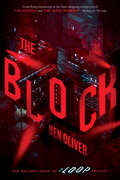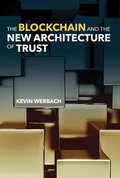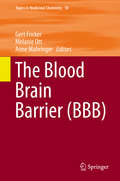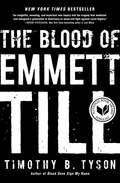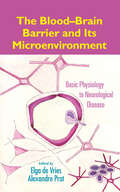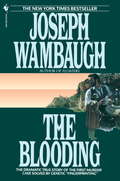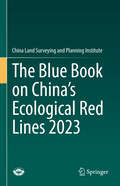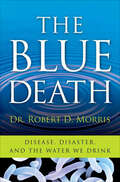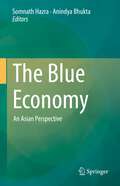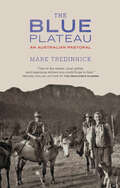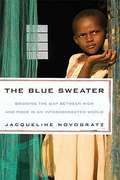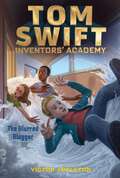- Table View
- List View
The Black Hole War: My Battle with Stephen Hawking to Make the World Safe for Quantum Mechanics
by Leonard SusskindWhat happens when something is sucked into a black hole? Does it disappear? Three decades ago, a young physicist named Stephen Hawking claimed it did-and in doing so put at risk everything we know about physics and the fundamental laws of the universe. Most scientists didn't recognize the import of Hawking's claims, but Leonard Susskind and Gerard t'Hooft realized the threat, and responded with a counterattack that changed the course of physics. THE BLACK HOLE WAR is the thrilling story of their united effort to reconcile Hawking's revolutionary theories of black holes with their own sense of reality-effort that would eventually result in Hawking admitting he was wrong, paying up, and Susskind and t'Hooft realizing that our world is a hologram projected from the outer boundaries of space.A brilliant book about modern physics, quantum mechanics, the fate of stars and the deep mysteries of black holes, Leonard Susskind's account of the Black Hole War is mind-bending and exhilarating reading.
The Black Hole-Neutron Star Binary Merger in Full General Relativity
by Koutarou KyutokuThis thesis presents a systematic study of the orbital evolution, gravitational wave radiation, and merger remnant of the black hole-neutron star binary merger in full general relativity for the first time. Numerical-relativity simulations are performed using an adaptive mesh refinement code, SimulAtor for Compact objects in Relativistic Astrophysics (SACRA), which adopts a wide variety of zero-temperature equations of state for the neutron star matter. Gravitational waves provide us with quantitative information on the neutron star compactness and equation of state via the cutoff frequency in the spectra, if tidal disruption of the neutron star occurs before the binary merges. The cutoff frequency will be observed by next-generation laser interferometric ground-based gravitational wave detectors, such as Advanced LIGO, Advanced VIRGO, and KAGRA. The author has also determined that the mass of remnant disks are sufficient for the remnant black hole accretion disk to become a progenitor of short-hard gamma ray bursts accompanied by tidal disruptions and suggests that overspinning black holes may not be formed after the merger of even an extremely spinning black hole and an irrotational neutron star.
The Black Mirror
by Raymond TallisIn this beautifully written personal meditation on life and living, Raymond Tallis reflects on the fundamental fact of existence: that it is finite. Inspired by E. M. Forster's thought that "Death destroys a man but the idea of it saves him," Tallis invites readers to look back on their lives from a unique standpoint: one's own future corpse. From this perspective, he shows, the world now vacated can be seen most clearly in all its richness and complexity. Tallis blends lyrical reflection, humor, and the occasional philosophical argument as he explores his own postmortem recollections. He considers the biological processes and the senses that opened up his late world and the million-nooked space in which he passed his life. His inert, dispossessed body highlights his ceaseless activity in life, the mind-boggling inventory of his possessions, and the togetherness and apartness that characterized his relationships in the material and social worlds. Tallis also touches on the idea of a posthumous life in the memories of those who outlive him. Readers who accompany Tallis as he considers his life through death will appreciate with new intensity the precariousness and preciousness of life, for here he succeeds in his endeavor to make "the shining hour" shine more brightly.
The Black spotted, Yellow Borer, Conogethes punctiferalis Guenée and Allied Species
by Akshay Kumar ChakravarthyConogethes is a group of moths distributed in Austral-Asian region from India to New Guinea, the Solomon Islands and Australia.The moths are also found in Hawaii and Great Britain. Conogethes is mostly known for the economic impact of its larvae on agricultural crops. Substantial research has been undertaken in order to understand the biology of these harmful insects and to develop strategies to confine their impact. Research on chemical communication between males and females via sex pheromones is in progress.Recent research has also focused on the acoustic communication of Conogethes. The moths can feed on more than 200 plants in diversified habitats. The borer moths have become major pest on Horticultural , Agricultural,Avenue trees and forest trees. Its a pest of Quarantine importance as it has been found in Exportable commodities. The book contains 22 chapters from a dozen countries. The authors are from China, Vietnam, Australia, Sri Lanka, Malaysia, Norway etc. This is the first book on the pest globally where interesting insights are provided. This is one of the book of its kind on single pest dealing with almost all aspects of its biology and management on cultivated crops.
The Blank Slate: The Modern Denial of Human Nature
by Steven PinkerThe Blank Slate shows how many intellectuals have denied the existence of human nature by embracing three linked dogmas: the Blank Slate, the Noble Savage, and the Ghost in the Machine. Each dogma carries a moral burden, so their defenders have engaged in desperate tactics to discredit the scientists who are now challenging them.
The Blind Spot
by William ByersIn today's unpredictable and chaotic world, we look to science to provide certainty and answers--and often blame it when things go wrong. The Blind Spot reveals why our faith in scientific certainty is a dangerous illusion, and how only by embracing science's inherent ambiguities and paradoxes can we truly appreciate its beauty and harness its potential. Crackling with insights into our most perplexing contemporary dilemmas, from climate change to the global financial meltdown, this book challenges our most sacredly held beliefs about science, technology, and progress. At the same time, it shows how the secret to better science can be found where we least expect it--in the uncertain, the ambiguous, and the inevitably unpredictable. William Byers explains why the subjective element in scientific inquiry is in fact what makes it so dynamic, and deftly balances the need for certainty and rigor in science with the equally important need for creativity, freedom, and downright wonder. Drawing on an array of fascinating examples--from Wall Street's overreliance on algorithms to provide certainty in uncertain markets, to undecidable problems in mathematics and computer science, to Georg Cantor's paradoxical but true assertion about infinity--Byers demonstrates how we can and must learn from the existence of blind spots in our scientific and mathematical understanding. The Blind Spot offers an entirely new way of thinking about science, one that highlights its strengths and limitations, its unrealized promise, and, above all, its unavoidable ambiguity. It also points to a more sophisticated approach to the most intractable problems of our time.
The Blind Spot: Science and the Crisis of Uncertainty
by William ByersIn today's unpredictable and chaotic world, we look to science to provide certainty and answers--and often blame it when things go wrong. The Blind Spot reveals why our faith in scientific certainty is a dangerous illusion, and how only by embracing science's inherent ambiguities and paradoxes can we truly appreciate its beauty and harness its potential. Crackling with insights into our most perplexing contemporary dilemmas, from climate change to the global financial meltdown, this book challenges our most sacredly held beliefs about science, technology, and progress. At the same time, it shows how the secret to better science can be found where we least expect it--in the uncertain, the ambiguous, and the inevitably unpredictable. William Byers explains why the subjective element in scientific inquiry is in fact what makes it so dynamic, and deftly balances the need for certainty and rigor in science with the equally important need for creativity, freedom, and downright wonder. Drawing on an array of fascinating examples--from Wall Street's overreliance on algorithms to provide certainty in uncertain markets, to undecidable problems in mathematics and computer science, to Georg Cantor's paradoxical but true assertion about infinity--Byers demonstrates how we can and must learn from the existence of blind spots in our scientific and mathematical understanding. The Blind Spot offers an entirely new way of thinking about science, one that highlights its strengths and limitations, its unrealized promise, and, above all, its unavoidable ambiguity. It also points to a more sophisticated approach to the most intractable problems of our time.
The Blind Spot: Why Science Cannot Ignore Human Experience
by Marcelo Gleiser Adam Frank Evan ThompsonA compelling argument for including the human perspective within science, and for how human experience makes science possible.&“This is by far the best book I've read this year.&” —Michael Pollan, Professor of the Practice of Non-fiction, Harvard University; #1 New York Times bestselling author&“(A) stimulating manifesto for changing the way we look at things.&” —Wall Street JournalIt&’s tempting to think that science gives us a God&’s-eye view of reality. But we neglect the place of human experience at our peril. In The Blind Spot, astrophysicist Adam Frank, theoretical physicist Marcelo Gleiser, and philosopher Evan Thompson call for a revolutionary scientific worldview, where science includes—rather than ignores or tries not to see—humanity&’s lived experience as an inescapable part of our search for objective truth. The authors present science not as discovering an absolute reality but rather as a highly refined, constantly evolving form of human experience. They urge practitioners to reframe how science works for the sake of our future in the face of the planetary climate crisis and increasing science denialism.Since the dawn of the Enlightenment, humanity has looked to science to tell us who we are, where we come from, and where we&’re going, but we&’ve gotten stuck thinking we can know the universe from outside our position in it. When we try to understand reality only through external physical things imagined from this outside position, we lose sight of the necessity of experience. This is the Blind Spot, which the authors show lies behind our scientific conundrums about time and the origin of the universe, quantum physics, life, AI and the mind, consciousness, and Earth as a planetary system. The authors propose an alternative vision: scientific knowledge is a self-correcting narrative made from the world and our experience of it evolving together. To finally &“see&” the Blind Spot is to awaken from a delusion of absolute knowledge and to see how reality and experience intertwine.The Blind Spot goes where no science book goes, urging us to create a new scientific culture that views ourselves both as an expression of nature and as a source of nature&’s self-understanding, so that humanity can flourish in the new millennium.
The Blind Watchmaker: Why the Evidence of Evolution Reveals a Universe Without Design
by Richard DawkinsThe title of this 1986 work, Dawkins's second book, refers to the Rev. William Paley's 1802 work, Natural Theology, which argued that just as finding a watch would lead you to conclude that a watchmaker must exist, the complexity of living organisms proves that a Creator exists. Not so, says Dawkins: "All appearances to the contrary, the only watchmaker in nature is the blind forces of physics, albeit deployed in a very special way... it is the blind watchmaker."
The Blind Watchmaker: Why the Evidence of Evolution Reveals a Universe without Design
by Richard DawkinsRichard Dawkins's classic remains the definitive argument for our modern understanding of evolution. The Blind Watchmaker is the seminal text for understanding evolution today. In the eighteenth century, theologian William Paley developed a famous metaphor for creationism: that of the skilled watchmaker. In The Blind Watchmaker, Richard Dawkins crafts an elegant riposte to show that the complex process of Darwinian natural selection is unconscious and automatic. If natural selection can be said to play the role of a watchmaker in nature, it is a blind one--working without foresight or purpose. In an eloquent, uniquely persuasive account of the theory of natural selection, Dawkins illustrates how simple organisms slowly change over time to create a world of enormous complexity, diversity, and beauty.
The Block (The Loop)
by Ben OliverIn the second book of The Loop trilogy, Luka is trapped in a fate worse than death. But now that he knows the truth about what he and his fellow inmates are being used for, it's more important than ever that he not only escapes, but that he builds an army.Luka is a prisoner once again. But this time it's a fate worse than death. In the Block, he must toggle between enduring an Energy Harvest for twelve hours of the day and surviving complete immobilization. The only semblance of relief is the Sane Zone, created to keep prisoners from going completely mad. In this virtual reality, the prisoners live out their fantasies of life outside. But for Luka, it's different.Happy is determined to find out the location of his friends, who disappeared after the Battle of Midway Park. But can Luka battle the descent into madness long enought to stop Happy's manipulation tactics and keep his friends' location safe?Another prison break is the only chance to protect the Missing. And as reality becomes increasingly scrambled on the outside, it'll take an army to stop Galen from carrying out his plans.
The Blockchain and the New Architecture of Trust (Information Policy)
by Kevin WerbachHow the blockchain—a system built on foundations of mutual mistrust—can become trustworthy.The blockchain entered the world on January 3, 2009, introducing an innovative new trust architecture: an environment in which users trust a system—for example, a shared ledger of information—without necessarily trusting any of its components. The cryptocurrency Bitcoin is the most famous implementation of the blockchain, but hundreds of other companies have been founded and billions of dollars invested in similar applications since Bitcoin's launch. Some see the blockchain as offering more opportunities for criminal behavior than benefits to society. In this book, Kevin Werbach shows how a technology resting on foundations of mutual mistrust can become trustworthy. The blockchain, built on open software and decentralized foundations that allow anyone to participate, seems like a threat to any form of regulation. In fact, Werbach argues, law and the blockchain need each other. Blockchain systems that ignore law and governance are likely to fail, or to become outlaw technologies irrelevant to the mainstream economy. That, Werbach cautions, would be a tragic waste of potential. If, however, we recognize the blockchain as a kind of legal technology that shapes behavior in new ways, it can be harnessed to create tremendous business and social value.
The Blood Brain Barrier (BBB)
by Gert Fricker Melanie Ott Anne MahringerMedicinal chemistry is both science and art. The science of medicinal chemistry offers mankind one of its best hopes for improving the quality of life. The art of medicinal chemistry continues to challenge its practitioners with the need for both intuition and experience to discover new drugs. Hence sharing the experience of drug research is uniquely beneficial to the field of medicinal chemistry. Drug research requires interdisciplinary team-work at the interface between chemistry, biology and medicine. Therefore, the topic-related series Topics in Medicinal Chemistry covers all relevant aspects of drug research, e. g. pathobiochemistry of diseases, identification and validation of (emerging) drug targets, structural biology, drugability of targets, drug design approaches, chemogenomics, synthetic chemistry including combinatorial methods, bioorganic chemistry, natural compounds, high-throughput screening, pharmacological in vitro and in vivo investigations, drug-receptor interactions on the molecular level, structure-activity relationships, drug absorption, distribution, metabolism, elimination, toxicology and pharmacogenomics. In general, special volumes are edited by well known guest editors.
The Blood of Emmett Till
by Timothy B. TysonThis extraordinary New York Times bestseller reexamines a pivotal event of the civil rights movement—the 1955 lynching of Emmett Till—&“and demands that we do the one vital thing we aren&’t often enough asked to do with history: learn from it&” (The Atlantic). * A New York Times Notable Book * A Washington Post Notable Book * Longlisted for the National Book Award * Winner of the Robert F. Kennedy Book Award *An NPR, Los Angeles Times, and Atlanta Journal-Constitution Best Book of the Year *In 1955, white men in the Mississippi Delta lynched a fourteen-year-old from Chicago named Emmett Till. His murder was part of a wave of white terrorism in the wake of the 1954 Supreme Court decision that declared public school segregation unconstitutional. Only weeks later, Rosa Parks thought about young Emmett as she refused to move to the back of a city bus in Montgomery, Alabama. Five years later, Black students who called themselves &“the Emmett Till generation&” launched sit-in campaigns that turned the struggle for civil rights into a mass movement. Till&’s lynching became the most notorious hate crime in American history. But what actually happened to Emmett Till—not the icon of injustice, but the flesh-and-blood boy? Part detective story, part political history, The Blood of Emmett Till &“unfolds like a movie&” (The Atlanta Journal-Constitution), drawing on a wealth of new evidence, including a shocking admission of Till&’s innocence from the woman in whose name he was killed. &“Jolting and powerful&” (The Washington Post), the book &“provides fresh insight into the way race has informed and deformed our democratic institutions&” (Diane McWhorter, Pulitzer Prize–winning author of Carry Me Home) and &“calls us to the cause of justice today&” (Rev. Dr. William J. Barber, II, president of the North Carolina NAACP).
The Blood-Brain Barrier and Its Microenvironment: Basic Physiology to Neurological Disease
by Elga De Vries Alexandre PratThis reference analyzes the cellular and molecular biology and mechanisms of the blood-brain barrier (BBB) and presents the most recent studies on the role of the BBB in the development and initiation of a wide range of physiological and pathological conditions affecting the central nervous system.
The Blooding
by Joseph WambaughFor the first time, Joseph Wambaugh turns his attention outside the United States to deal with two murders in neighboring English Midlands villages-ancient villages that still have whitewashed Tudor cottages, pavements too narrow for passing baby prams, streets barely wide enough for two cars, and churches or pubs as the sites of community life. What intrigues the master of true-crime writing is that out of the sleepy setting grew a landmark case: the first murders solved by genetic fingerprinting. The victims of the terrifying rape-murders -two fifteen-year-old girls who do not know each other-have in common one fatal mistake: they choose to walk village footpaths bordering the lands of a psychiatric hospital. Forever after, the names Ten Pound Lane and The Black Pad will evoke fear and dread. The murders occur three years apart, and during all those years the members of the Leicestershire constabulary never give up their search. The local newspapers cooperate by keeping the cases alive. And the families of the victims try to cope with the chaos of their existence.
The Blooding
by Joseph WambaughFifteen-year-old Lynda Mann's savagely raped and strangled body is found along a shady footpath near the English village of Narborough. Though a massive 150-man dragnet is launched, the case remains unsolved. Three years later the killer strikes again, raping and strangling teenager Dawn Ashforth only a stone's throw from where Lynda was so brutally murdered. But it will take four years, a scientific breakthrough, the largest manhunt in British crime annals, and the blooding of more than four thousand men before the real killer is found.
The Blue Book on China’s Ecological Red Lines 2023
by China Land Surveying and Planning InstituteThis book is the first blue book on the research outcomes of Ecological Red Lines (ERLs) of China. It systematically summarizes the process, methodology, achievements, and practical case studies, putting forward ideas and suggestions to strengthen the supervision and administration of ERLs. It is a reference for policy makers and all sectors of society. Chapters are carefully developed to cover (1) introduction of delineating ERLs, (2) progress and methodology, (3) achievements, (4) management and control measures, (5) practical case studies of local government. It is a valuable read for researchers of ecological conservation engineering as well as organizations engaged in ecological civilization practice.
The Blue Death: Disease, Disaster, and the Water We Drink
by Robert D. MorrisA public health expert warns about the safety of our water supply and “recounts, with crystal clarity, some of history’s epic drinking water disasters” (Booklist, starred review).A Library Journal Best Consumer Health Book of the YearIn this book, Dr. Robert Morris chronicles the fascinating and at times frightening story of our drinking water. His gripping narrative recounts the epidemics that have shaken cities and nations, the scientists who reached into the invisible and emerged with controversial truths that would save millions of lives, and the economic and political forces that opposed these researchers in a ferocious war of ideas.In the gritty world of nineteenth-century England, amid the ravages of cholera, Morris introduces John Snow, the physician who proved that the deadly disease could be hidden in a drop of water. Decades later in the deserts of Africa, the story follows Louis Pasteur and Robert Koch as they race to find the cause of cholera and a means to prevent its spread. In the twentieth century, burgeoning cities would subdue cholera and typhoid by bending rivers to their will, building massive filtration plants, and bubbling poisonous gas through their drinking water. However, in the new millennium, the demon of waterborne disease is threatening to reemerge, and a growing body of research has linked the chlorine relied on for water treatment with cancer and stillbirths.In The Blue Death, Morris dispels notions of fail-safe water systems and reveals some shocking truths: the millions of miles of leaking water mains, constantly evolving microorganisms, and the looming threat of bioterrorism, which may lead to catastrophe. Across time and around the world, this account offers alarming information about the natural and man-made hazards present in the very water we drink.“While casual readers don’t generally pick up public health books expecting to stay up late turning pages, Morris manages a neat trick—he provides an in-depth medical history that at times reads like a mystery.” —San Francisco Chronicle Book Review“Engrossing and disquieting.” —Publishers Weekly“Morris approaches water systems like an engineers, disease outbreaks like an epidemiologist, and the people and events behind waterborne disasters like an investigative reporter . . . The effect is riveting.” —Kirkus Reviews (starred review)
The Blue Economy: An Asian Perspective
by Somnath Hazra Anindya BhuktaThis volume defines and analyzes the Blue Economy, a system that encompasses all the economic activities which are happening in and around the ocean within a sustainable development framework, with focus on countries in Asia. This work is timely, as Blue Economy activities account for a significant share of GDPs in the island and coastal economies in the Asia region, sustaining the livelihoods of one of the largest sections of the world's population. This book, therefore, assesses how the Blue Economy contributes to these livelihoods from economic and ecological perspectives and analyzes the various types of ecosystem services provided, and how these services are regulated and maintained. While most studies of the Blue Economy focus only on the economic aspects, this book provides ample statistical data to demonstrate why ecosystem services should additionally be considered for the estimation and valuation of the Blue economy. The book is primarily meant for researchers, students, and teachers in the fields of environmental and ocean economics, sustainable development, and ecosystem services, and will be of further interest to policymakers and government officials working in matters related to the Blue Economy and sustainability policy.
The Blue Plateau: An Australian Pastoral
by Mark TredinnickThe author of The Land’s Wild Music depicts Australia’s Blue Mountains through stories of the land and the lives within it.At the farthest extent of Australia’s Blue Mountains, on the threshold of the country’s arid interior, the Blue Plateau reveals the vagaries of a hanging climate: the droughts last longer, the seasons change less, and the wildfires burn hotter and more often. In The Blue Plateau, Mark Tredinnick tries to learn what it means to fall in love with a home that is falling away.A landscape memoir in the richest sense, Tredinnick’s story reveals as much about this contrary collection of canyons and ancient rivers, cow paddocks and wild eucalyptus forests as it does about the myriad generations who struggled to remain in the valley they loved. It captures the essence of a wilderness beyond subjugation, the spirit of a people just barely beyond defeat. Charting a lithology of indigenous presence, faltering settlers, failing ranches, floods, tragedy, and joy that the place constantly warps and erodes, The Blue Plateau reminds us that, though we may change the landscape around us, it works at us inexorably, with wind and water, heat and cold, altering who and what we are.The result is an intimate and illuminating portrayal of tenacity, love, grief, and belonging. In the tradition of James Galvin, William Least Heat-Moon, and Annie Dillard, Tredinnick plumbs the depths of people’s relationship to a world in transition.Praise for The Blue Plateau“One of the wisest, most gifted and ingenious writers you could hope to find.” —Michael Pollan, author of In Defense of Food and The Omnivore’s Dilemma“I’ve never been to Australia, but now—after this book—it comes up in my dreams. The landscape in the language of this work is alive and conscious, and Tredinnick channels it in prose both wild and inspired. . . . Part nonfiction novel, part classic pastoral, part nature elegy, part natural history, the whole of The Blue Plateau conveys a deep sense, rooted in the very syntax of a lush prose about an austere land, that there can be no meaningful division between nature and culture, between humans and all the other life that interdepends with us, not in the backcountry of southeastern Australia, nor anywhere else.” —Orion“Absorbed slowly, as a pastoral landscape of loss and experiment in seeing and listening, the book richly rewards that patience.” —Publishers Weekly
The Blue Sweater: Bridging the Gap between Rich and Poor in an Interconnected World
by Jacqueline NovogratzThe Blue Sweater is the inspiring story of a woman who left a career in international banking to spend her life on a quest to understand global poverty and find powerful new ways of tackling it.
The Blurred Blogger (Tom Swift Inventors' Academy #7)
by Victor AppletonTom and his friends track down a mysterious blogger who pushes pranks too far in this seventh novel in Tom Swift Inventors&’ Academy—perfect for fans of The Hardy Boys or Alex Rider series.A series of videos called &“The Not-so-Swift Academy&” are the talk of Tom Swift&’s tech-focused school. A mysterious host whose face is blurred shows hidden camera footage of different students being pranked—from a rubber tarantula leaping out of one of the terrariums to water flash freezing. Tom and his classmates are on edge, wondering which unlucky student will be the star of the next episode. They&’re on the lookout for hidden cameras and searching for signs of the next prank around every corner and behind every locker door. Tired of the tension, Sam decides to take matters in her own hands. She&’s going to bust the blogger by studying the videos for clues. But as Sam pieces the clues together, she unveils the biggest prank of all—someone&’s trying to frame her for the videos! Can Tom and his friends unmask the blurred blogger and clear Sam&’s name before they become the targets of the prankster&’s increasingly nefarious stunts?
The Board of Longitude: Science, Innovation and Empire
by Simon Schaffer Richard Dunn Rebekah Higgitt Alexi Baker Sophie WaringIn the first book-length history of the Board of Longitude, a distinguished team of historians of science bring to life one of Georgian Britain's most important scientific institutions. Having developed in the eighteenth century following legislation offering rewards for methods to determine longitude at sea, the Board came to support the work of navigators, instrument makers, clockmakers and surveyors, and assembled the Nautical Almanac. Utilizing the archives and records of the Board, recently digitised by the same team, the authors shed new light on the Board's involvement in colonial projects, Pacific and Arctic exploration, as well as on innovative practitioners whose work would otherwise be lost to history. This is an invaluable guide to science, state and society in Georgian Britain, a period of dramatic industrial and imperial and technological expansion.
The Boatman: Henry David Theoreau's River Years
by Robert M. ThorsonRobert Thorson gives readers a Thoreau for the Anthropocene. The boatman and backyard naturalist was keenly aware of the way humans had altered the waterways and meadows of his beloved Concord River Valley. Yet he sought out for solace and pleasure those river sites most dramatically altered by human invention and intervention—for better and worse.
